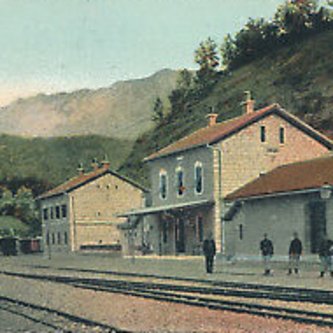ON THE INDUSTRIAL HISTORY OF MONTENEGRO
A tiny country dominated by craggy mountains and deep gorges, with next to no arable land, cut off from the sea for centuries: Montenegro had extremely poor prerequisites for successful industrialisation, or any kind of a flourishing economy.
Officially, Montenegro fell under Ottoman rule in the 15th century. As in the other Balkan nations, the scarce arable land fell into the hands of Turkish landowners, who did not concern themselves with modernising agriculture. The successful resistance of Montenegrin princes to Ottoman rule in the remote, impenetrable mountains, and their success in preserving considerable autonomy, did little to alleviate general poverty and backwardness.
The installation of a printing press in the village of Obod, near the capital of Cetinje, in 1493 – just a few years after the invention of printing – was a landmark event. But no cultural flowering could take root in this isolated, strife-torn land. Eeducation levels remained extremely low until well into the 20th century. Nor could Montenegro profit from the flourishing sea trade, to which the museum in the port city of Kotor bears testimony, as the Adriatic coast was divided between Venice and the Ottoman Empire.
When the country gained independence in 1878, Europe’s great powers granted Montenegro the coastal strip, but placed it under Habsburg control. Several shipping lines were launched in Kotor, and the Onogošt Brewery was founded in Nikšić. The Austrians opened a shipyard in Tivat for their navy, and built the first narrow-gauge railway into the interior in 1901. However, the economy depended solely on animal breeding, with cattle as the only significant export. The country was unable to feed itself, and half its budget was financed through subsidies paid by Russia to further its military strategy. Only a few scattered factories for agricultural and wood products appeared in the decade following.
In the “Kingdom of Serbs, Croats and Slovenes”, the first Yugoslavian state, founded in 1918, Montenegro remained the smallest and poorest part. A few Croatian textile companies opened operations there to take advantage of the low wages and taxes, and the cities of Nikšić and Podgorica grew. However, the miserable transportation links, high illiteracy and dramatic lack of capital stifled any further progress.
The founding of the Socialist Federal Republic of Yugoslavia in 1945 heralded an era of massive change. Montenegro’s capital was relocated to Podgorica (then “Titograd”) and the central government embarked on a programme of heavy industry expansion on the Soviet model. Mining of bauxite, the country’s most important raw material, began near Nikšić in 1948. As bauxite is the primary raw material for producing aluminium, the cornerstone for the KAP aluminium plant was laid in Podgorica in 1968. In Nikšić, soon celebrated as the “city of industry, steel and beer”, a greenfield steel works was erected which grew to become Montenegro’s largest industrial plant. Lead and zinc ore deposits were exploited, and lignite coal was mined.
As economic policy primarily promoted the exploitation of mineral resources, light industry grew slowly: refrigerator and shoe manufacturers opened their doors in the former capital of Cetinje, paper factories, sawmills and food processors emerged. The port of Bar was expanded and new rail links were planned to alleviate the massive transportation problems. Trains began service between Bar and Podgorica starting in 1959. The line was subsequently integrated in the long-distance line to Belgrade, which was completed in 1976. The most spectacular stretch lies a few kilometres north of Podgorica: a viaduct that crosses the gorge of the Mala Rijeka river at a height of 198 metres. It was recognised as the highest railway bridge in the world until Chinese engineers surpassed this record in 2001.
The country’s industrial production, amounting to around 5% in 1947, grew to over one third of overall economic output by the 1970s and the number of industrial workers exceeded agricultural employment significantly. Yet Montenegro was still one of the poor constituent republics of Yugoslavia when a devastating earthquake in 1979 set Montenegro’s economy back even further.
Montenegro was part of the 'Socialist Federal Republic of Yugoslavia', which disintegrated since 1991.
Therefore, for completeness, please also read our articles on the industrial history of the other states that were formerly part of Yugoslavia.
Bosnia and Herzegovina
Croatia
Kosovo
North Macedonia
Serbia
Slovenia


